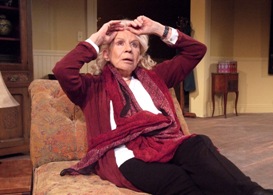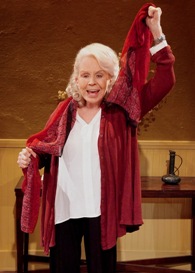
Salome Jens gives an absolutely riveting performance as Stella Goldschlag, the Berliner whose collaboration with the Gestapo sent thousands of her fellow German Jews to the death camps, in the American Premiere of Gail Louw’s Blonde Poison, now playing at Beverly Hills’ Theatre 40.
 The facts by themselves are cut-and-dry. Blonde, blue-eyed, and beautiful, Stella had managed to pass as Aryan till arrested by the Nazis in the spring of 1943. Given the choice between freedom or being sent to Auschwitz or Treblinka, Stella chose the former—provided that that she become a “catcher” on the prowl for human “U-boats,” i.e. Jews in hiding.
The facts by themselves are cut-and-dry. Blonde, blue-eyed, and beautiful, Stella had managed to pass as Aryan till arrested by the Nazis in the spring of 1943. Given the choice between freedom or being sent to Auschwitz or Treblinka, Stella chose the former—provided that that she become a “catcher” on the prowl for human “U-boats,” i.e. Jews in hiding.
So successful was she at sniffing out her onetime schoolmates that as many as 3000 of the 13,500 underground Jews apprehended by Stella and her fellow catchers owed their capture to the woman known as “Blonde Poison.”
Unlike these cut-and-dry facts, Blonde Poison The Play chooses to reveal the many shadings of what might otherwise seem to be a black-and-white story of evil incarnate.
Lowe’s award-winning solo piece does so by allowing us to get to know Stella the woman before giving us Stella the monster. Indeed it is not until an hour or so into Blonde Poison’s ninety-minute running time that the number 3000 is first uttered and Stella’s “sleeping with the enemy” (both figurative and literal) becomes the focus of her narrative.
 We are introduced to Stella at age seventy-one, alone as always in the elegantly furnished Berlin-adjacent flat she has called home for the past several decades and immersed in reading a letter, the significance of which will not be revealed until Blonde Poison’s final moments.
We are introduced to Stella at age seventy-one, alone as always in the elegantly furnished Berlin-adjacent flat she has called home for the past several decades and immersed in reading a letter, the significance of which will not be revealed until Blonde Poison’s final moments.
It soon becomes clear that Stella is awaiting the visit of a German-born American journalist come to interview the infamous “blonde ghost,” and that this man, Paul, was a former schoolmate of hers whose family escaped to the United States when he and Stella were only just entering their teens.
 Paul’s impending arrival sets Stella to reminiscing, and to revealing the internalized anti-Semitism that allowed her to see her prey as “scraggly, smelly … Eastern ones [with] their beards, those hats” who had nothing to do with Stella’s “real German family,” one that “had culture, … had Beethoven, Brahms, Mozart.” (Stella’s lover-turned-first husband Manfred Kübler may have been a Jew as well, but he too was blond, and handsome, and in Stella’s words “not Jewish.”)
Paul’s impending arrival sets Stella to reminiscing, and to revealing the internalized anti-Semitism that allowed her to see her prey as “scraggly, smelly … Eastern ones [with] their beards, those hats” who had nothing to do with Stella’s “real German family,” one that “had culture, … had Beethoven, Brahms, Mozart.” (Stella’s lover-turned-first husband Manfred Kübler may have been a Jew as well, but he too was blond, and handsome, and in Stella’s words “not Jewish.”)
And so we follow Stella through those early years of Nazism, years of segregated schooling and forced factory work leading up to the narrow escape she and her “Muti” managed to make when the Gestapo came to clear that factory of Jews.
Blonde Poison allows us to observe life in Nazi Germany through Stella’s eyes, allows us to experience the fear and desperation that contributed to the betrayal of her own people, and to ask ourselves as Fräulein Schneider does in Kander & Ebb’s Cabaret, “What Would You Do?”
Not that playwright Lowe sugarcoats Stella’s villainy. In one particularly chilling moment, we hear her speak of the near sexual charge she experienced upon witnessing a capture, and always under the surface lies the hideous anti-Semitism that Stella maintained throughout her conversion to Christianity and her eventual marriages to three non-Jews.
One of the reasons Louw’s play works so well is that it sees no need to invent an invisible conversation partner for Stella’s stroll down memory lane. She is simply a woman so long alone that thinking out loud has become a matter of course, and if ever there was a day for verbal introspection, today is that day.
Blonde Poison debuted at the 2012 Brighton Festival (England’s largest), where it won the Argus Angel Award for Artistic Excellence. Not until now, however, has it had the kind of fully-staged production offered by Theatre 40’s crackerjack design team, one made even more noteworthy by the imaginative, nuanced direction of Jules Aaron and the superlative work of Salome Jens, who next year celebrates the sixtieth-anniversary of her Broadway debut.
 Jens gives us all of Stella’s fire and ice and everything in between, and if her delivery is a tad slow at times, it seems organic to the character. (Still, I wouldn’t have minded a ten-minute trim from Blonde Poison’s first hour.)
Jens gives us all of Stella’s fire and ice and everything in between, and if her delivery is a tad slow at times, it seems organic to the character. (Still, I wouldn’t have minded a ten-minute trim from Blonde Poison’s first hour.)
Scenic designer Jeff G. Rack gives us a meticulously appointed apartment for Stella to call home, with era-appropriate turntable and TV set and a stunning Arnette Zerbe painting (of a younger Stella?) hanging on the wall. Ric Zimmerman’s lighting design is as nuanced as are Aaron’s direction and Jens’ performance. Joseph “Sloe” Slawinski’s occasion insertion of Max Kinberg’s original musical and the ace sound designer’s effects are both pitch-perfect. Costume designer Michèle Young and makeup and wig designer Judi Lewin give Stella just the right look of blonde elegance. Dialect coach Linda Brennan insures that Stella’s German accent remains subtle, as it should be. Vesna Tolomanoska is assistant to the director.
Blonde Poison is produced by David Hunt Stafford. Benjamin Scuglia is stage manager.
With solo shows a dime a dozen these days (or at least during Fringe Festival season), it’s rare that a solo perfromance stands out as a piece of dramatic theater that could just as easily be a full-fledged, multi-character play, mini-series, or film.
Blonde Poison is just such a solo show, and because it is Salome Jens going solo at Theatre 40, this is one one-woman-show well worth seeing.
Theatre 40, 241 S. Moreno Dr., Beverly Hills.
www.Theatre40.org
–Steven Stanley
January 10, 2015
Photos: Ed Krieger
Tags: Los Angeles Theater Review, Salome Jens, Stella Goldschlag, Theatre 40



 Since 2007, Steven Stanley's StageSceneLA.com has spotlighted the best in Southern California theater via reviews, interviews, and its annual StageSceneLA Scenies.
Since 2007, Steven Stanley's StageSceneLA.com has spotlighted the best in Southern California theater via reviews, interviews, and its annual StageSceneLA Scenies.







 COPYRIGHT 2025 STEVEN STANLEY :: DESIGN BY
COPYRIGHT 2025 STEVEN STANLEY :: DESIGN BY